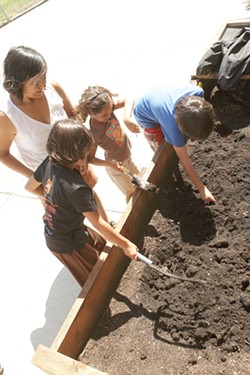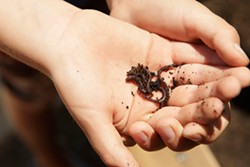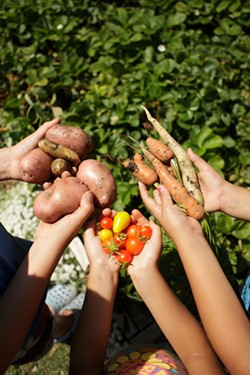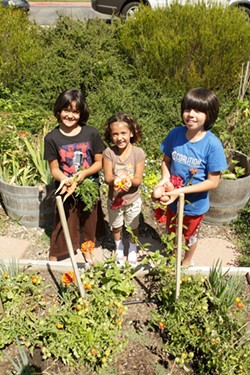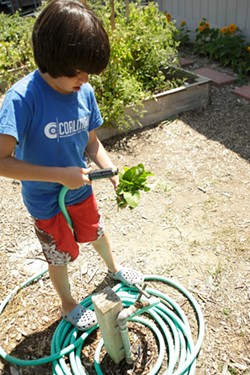[{
"name": "Ad - Medium Rectangle CC01 - 300x250",
"id": "AdMediumRectangleCC01300x250",
"class": "inlineCenter",
"insertPoint": "8",
"component": "2963441",
"requiredCountToDisplay": "12"
},{
"name": "Ad - Medium Rectangle LC01 - 300x250",
"id": "AdMediumRectangleCC01300x250",
"class": "inlineCenter",
"insertPoint": "18",
"component": "2963441",
"requiredCountToDisplay": "22"
},{
"name": "Ad - Medium Rectangle LC09 - 300x250",
"id": "AdMediumRectangleLC09300x250",
"class": "inlineCenter",
"insertPoint": "28",
"component": "3252660",
"requiredCountToDisplay": "32"
}]
Defying the budgetary ax swinging over public education, a sturdy sprout with a distinctly greenish tinge is growing in San Luis Obispo County schools.
From worm bins to water conservation, from gardens to greenhouse gas emissions, schools are finding creative ways to help today’s students learn about the real world.
“There’s a new interest in environmental education from parents. They want to know, ‘What is my kid learning about how to be an environmentally responsible citizen when they grow up?’” said Celeste Royer, an environmental education specialist with the SLO County Office of Education.
Schools from kindergarten to high schools are responding, whether the focus is fresh greens harvested from school gardens for the cafeteria salad bar or a better understanding of the water cycle in action.
“We’ve found that children are more excited in hands-on learning. They become more engaged, and more willing to learn,” Royer added.
Four years of green learning
Atascadero High School provides a prime example of this hands-on approach to environmental education. A comprehensive new program known as the Green Academy is starting up when the school opens its doors later this month.
Sixty incoming freshmen have enrolled in the Green Academy, where together they’ll take four years of classes with an emphasis on the environment.
“Instead of English, they’ll have green English; they’ll have green study hall and green biology,” explained John Miron, a science teacher who’s been involved in developing the new program.
The idea had its origins last summer, with the announcement of plans for several large solar energy projects in the Carrizo Plains, within the Atascadero school district boundaries. School officials hoped for a property-tax-based funding windfall similar to the one San Luis Coastal Unified School District has received over the years from the Diablo Canyon Nuclear Power Plant. Instead, they were disappointed to discover that the solar companies are exempt from property taxes,
Still, Miron and other teachers were interested in preparing local students for employment in the burgeoning solar industry.
“Then we discovered the jobs out there involve the ability to operate heavy equipment, run a trencher or drive a forklift. We realized there aren’t going to be a whole lot of jobs out there for our kids once construction is finished. The truth is not every kid will have the opportunity to work in solar,” he said.
The concept widened to include green energy, energy efficiency, and sustainability in general, to help students become “highly employable,” Miron noted.
The James Irvine Foundation offered a $25,000 grant through its ARCHES program, designed to improve education for students who otherwise might not go to college or even finish high school. That money has funded the planning effort for the Green Academy over the last year.
More than 100 eighth-graders were interviewed for the new program as part of an elaborate selection process, said Kimberly McGrath, Atascadero High’s assistant principal for curriculum and instruction.
Half of those selected are considered underachievers or socioeconomically disadvantaged, reflecting the James Irvine Foundation’s grant requirements.
“These kids are already interested in green. There are kids who are at the top of the class and that’s what they happen to love. There are kids who are at the bottom of the class and that’s what they happen to love.
“The thought is to get what the kids are interested in and that’s how you hook them,” McGrath said.
Although solar energy was the starting point, the idea ballooned, she explained. “Our entire country is looking at energy conservation. We started looking at what kinds of education kids need to be prepared for the world. It broadened into alternative energy, and from there into sustainability.
“We have to prepare kids to be thinking problem solvers. If it’s real, it hooks them.”
Green Academy students will learn “how our campus works,” said Miron, “how much energy and water do we use, how much waste do we produce, and how do we reduce that. At the same time, they’re looking at how do motors work, how does an electromagnetic system work. They’re getting the tools to further their understanding.”
The students will still be mastering the required state standards, McGrath said. In green English class, for example, teachers will have enough flexibility to teach concepts such as author’s point of view, connotation, and denotation, using environmental articles or books such as Rachel Carson’s Silent Spring.
Students will also have the opportunity to work with mentors from the community, on issues such as an inventory of greenhouse gas emissions or establishing worm bins—“a vermiculture program”—for the school district’s food waste. They can learn how to prevent pollution of the nearby creek, or how to grow tomatoes and herbs for the school’s hospitality program.
So far, school officials have only developed the first year of instruction for the academy’s four-year program. In coming years when the students are juniors or seniors, they’ll be able to take Cuesta College classes to earn green certification.
“We’re trying to build school leaders. How can they be a change movement?” said Kathy Hannemann, assistant superintendent for the Atascadero school district.
Calling the Green Academy “exciting,” she added, “It’s really a new and different thing for freshmen to become leaders.”
Exciting or not, the program is not receiving any funding from the school district. School officials are still waiting to hear if they’ll receive a $50,000 grant from the James Irvine Foundation to implement the innovative effort.
Still, “we’re moving forward with or without the grant,” Hannemann said. The teaching strategy can happen even without the funds, although there would be fewer opportunities for field trips.
Real ecology
One local field-trip destination remains popular among SLO County students, especially at the elementary level: Rancho El Chorro outdoor school, located in an oak woodland across from Cuesta College.
Schoolchildren from kindergarten through fourth grade have the opportunity for a one-day visit, learning about wildlife, plants, and insects. Fifth- and sixth-graders can stay for up to five days, studying everything from astronomy to freshwater ecology.
The funds for visiting Rancho El Chorro are raised by parent-teacher associations and by the students themselves. State budget cuts probably won’t make much of a difference to these fundraising efforts, and sign-ups for the coming school year are already greater than last year.
“Using the environment to teach concepts really does help students learn,” said the County Office of Education’s Royer, who is the director of the outdoor school. “Don’t teach virtual ecosystems, teach real ecosystems. Rancho El Chorro is the perfect example.
“There’s a demonstrated need and interest in outdoor education and having this outdoor experience. People connect to the natural world.”
Teaching at the outdoor school is still based on state standards, “but we’re doing it in nature’s classroom rather than within four walls,” Royer said. The 200-acre campus includes a creek, a pond, and plenty of trees, “plus bobcats, deer, snakes, and lizards come out of the bushes.”
Environmental educators at Rancho El Chorro use different teaching techniques to reach all learning styles.
“Maybe some students can see the water cycle in a science textbook, and they might not get it. But when they see it as music, dance it, sing it, they get it,” she said.
Gardens galore
Hands-on learning in school vegetable gardens is also growing, thanks to an active network of parents and other community volunteers.
“There’s a lot of interest in garden-based programs in this county,” Royer said. “There’s a lot of interest in connecting organics, nutrition, obesity, and the environment.”
Grant funding from the state’s Wellness Program two years ago helped pay for school garden projects for all the schools in San Luis Coastal school district. Today, that funding has withered, but many of the gardens continue to thrive.
At Pacheco Elementary in San Luis Obispo, the students “all love the garden,” according to the Principal Rick Mayfield. “Our parent community will make it keep happening. It’s too worthwhile. Hands-on learning is the best thing.”
Mayfield said the school’s garden is good for lessons at all grade levels, including health, science, and social studies. Another plus: “Whatever you pick from the garden tastes so much better than what you buy in the store.”
Amalia Galpert, a classroom aide and parent volunteer for Pacheco’s garden club, hand-watered the lush vegetable beds on a recent sunny morning. Tucked in a corner away from the school playground, rambling tomato plants were covered with bright red fruit ready for plucking. A raised bed of strawberries was thriving, edged with colorful nasturtium flowers.
Galpert said she decided to help students learn how to grow organic food as her contribution to reducing global warming. Other volunteers have also joined the effort, helping to raise money and find donations from local businesses to keep the garden growing.
“We start the school year with peas, greens, and strawberries. All year long, this is working,” she said, rolling her hands to represent the cycle. Beans, potatoes, and grapes grow along with herbs and flowers.
“It’s very successful, but it’s never enough. The kids eat everything they can. I don’t think a ripe strawberry has ever left this area!
“The garden benefits all the kids. They come here during recess, and just munch whatever they find,” said Galpert as she moved around the raised beds and wine barrel planters.
She reached behind a barrel to a sloping hill where plant clippings had been slowly composting, and yanked out a healthy, self-planted carrot. Knocking the soil off it, she handed it to a hungry visitor, saying, “Voila! This is the bounty.”
Near the school’s cafeteria, an extensive worm bin provides another hands-on lesson. Students separate the food waste from their lunchtime trash to feed the worms, which in turn create rich compost for the garden. Inside the sturdy wooden bins—built by volunteers—Galpert’s trowel reveals a writhing mass of reddish worms in the dark compost.
More garden beds line the outdoor play area for kindergartners, with glass windows designed to let youngsters see what’s happening below the soil line. Little signs in English and Spanish denote the crops that will soon be planted: “Radish. Rabano.” “Carrots. Zanahorias.” “Beans. Habichuela (Frijoles).”
The older kids enjoy the kindergarteners’ garden too, Principal Mayfield said.
Closer to the coast, over at Morro Bay High School, tomatoes, cabbage, bok choy, and basil are growing in the school garden in front of the science building. Science teacher Faylla Chapman worked with the school’s environmental club to develop the raised beds built two years ago with state grant funds.
She set up an experiment to compare vegetables’ growth rates in potting soil compared to biosolids from the wastewater treatment plant.
“The tomatoes grew and grew in the biosolids, but there’s no fruit. It’s a learning process,” Chapman said, adding that a read-out from the city shows the biosolids contain “very little heavy metals.” The biggest problem with the material, she said, is the phosphate-laden detergent from the laundromat.
For the coming school year, Chapman is hoping to involve home economics and special education classes in the garden. Including other students is difficult, she said, because the emphasis for high-schoolers is on meeting state standards.
“There’s one standard that talks about photosynthesis. There’re no standards in biology that cover gardening. The ecology standards encompass different things, but that’s usually the last in the year. There’s no time to do the garden as a class,” she said.
“My feeling is that as long as we have state standards, it will be very difficult to work a lot of environmental education in at the high school level. But if teachers take the time to work it into the curriculum, it can be done. Until somebody does it and shows us how, it makes it very difficult.”
Atascadero High School’s Green Academy is aiming to do just that, according to Hannemann, the assistant superintendent at the Atascadero school district.
“That’s the whole point, how to weave our [green] content into our core classes, to create curriculum that can be transferred to any school so they can use it as their own,” Hannemann said.
As Atascadero High’s assistant principal McGrath pointed out, “Any time you can get it real, and get what they’re interested in, kids can zoom to a higher level. You can see how high you can get them to fly.”
Environmental journalist Kathy Johnston can be reached at [email protected].
Latest in News
Readers also liked…
-

Coast Unified teachers upset over new position's salary and qualifications
Oct 20, 2022 -

SLO police identify alleged driver who hit and killed couple
Dec 22, 2022 -

When the levee breaks: Oceano residents, county officials walk a tightrope of regulations to manage Arroyo Grande Creek, which some say led to the levee's failure in January
May 18, 2023

